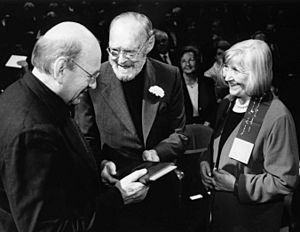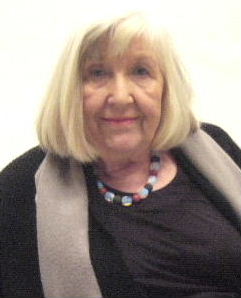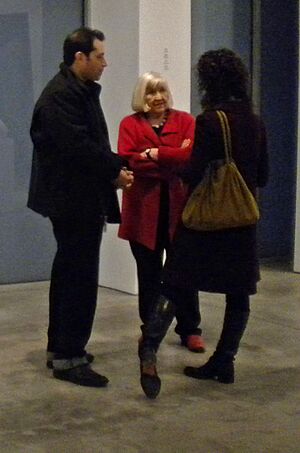Bernd and Hilla Becher facts for kids
Bernd Becher (born August 20, 1931 – died June 22, 2007) and Hilla Becher (born September 2, 1934 – died October 10, 2015) were a famous German husband-and-wife team. They were artists and photographers who worked together. They are best known for their huge collections of photos, called "typologies," of industrial buildings. These photos were often arranged in neat grids. They started what is now known as the 'Becher school' of photography. This school influenced many photographers and artists around the world. They won important awards like the Erasmus Prize and the Hasselblad Award.
Contents
About Their Lives
Bernd Becher was born in a town called Siegen. He studied painting and then how to design text (typography) at art schools in Germany. Hilla Becher was born in Potsdam. Before studying photography at the Kunstakademie Düsseldorf, she trained to be a photographer in her hometown.
Bernd and Hilla both worked as freelance photographers, taking pictures for advertising. They focused on product photography. They got married in 1961.
Their Amazing Work
Bernd and Hilla met as students in 1957. They started working together in 1959. Their goal was to photograph and record German industrial buildings that were slowly disappearing. They started in the Ruhr Valley, where Bernd's family had worked in steel and mining.
They were really interested in how similar some of these buildings looked. After taking thousands of pictures of different structures, they noticed that many buildings, like cooling towers or gas tanks, shared similar shapes. They also found it cool that many industrial buildings were designed with a lot of care.
How They Photographed
The Bechers first used a smaller camera. After 1961, they mostly used a special, large camera called a large format monorail camera. This camera allowed them to keep all the lines in their photos perfectly straight. They took pictures of buildings from different angles, but always in a very direct and "objective" way. This means they tried to show the buildings exactly as they were, without adding their own feelings.
They used different lenses to make sure similar buildings looked the same size, even if they had to photograph them from different distances. They chose to work in black and white photography. This was because black and white photos could show the shapes of buildings clearly without colors distracting you. It was also more reliable and cheaper back then. They often took two pictures of each view.
Bernd and Hilla shared the work in the darkroom. Bernd would develop the negatives, and Hilla would make the prints. To make the sky look white in their pictures, they often took photos on cloudy days. They also sometimes photographed early in the morning during spring or fall.
What They Photographed
They photographed many types of industrial buildings, including:
- Framework houses (buildings with wooden frames)
- Barns
- Water towers
- Coal tipples (where coal is loaded)
- Cooling towers
- Grain elevators
- Coal bunkers
- Coke ovens
- Oil refineries
- Blast furnaces
- Gas tanks
- Storage silos
- Warehouses
At each location, they also took wider pictures of the whole industrial area. This helped show how the different structures fit together. They made sure to remove any details that weren't important to their main idea. Instead, they focused on comparing how buildings looked from different viewpoints and in different light.
Their "Typologies"
The Bechers displayed their photos, usually black and white prints, in grids of six, nine, or fifteen pictures. By the mid-1960s, they had a favorite way to show their work. They would put pictures of buildings with similar uses side by side. This invited people to compare their shapes and designs. They called these organized sets of photographs "typologies." The titles of their works were short, and the captions only mentioned the time and place.
Later, for an exhibition in New York, they also started showing single, larger photos. These were presented on their own, not in grids.
Teaching and Influence
In 1976, Bernd Becher started teaching photography at the Kunstakademie Düsseldorf. He taught there until 1996. Before him, photography wasn't really part of the school, which was mostly for painters. He had a huge influence on his students, many of whom became very famous photographers themselves. Some of his former students include Andreas Gursky, Thomas Ruff, and Thomas Struth.
After Bernd Becher passed away, Hilla continued to put together their works, mostly using photos they had already taken.
Exhibitions Around the World
The Bechers had their first art gallery show in 1963. Their work became more known in the United States when their book Anonyme Skulpturen (Anonymous Sculptures) was published in 1970. Their photos were shown at important places like the George Eastman Museum and the Sonnabend Gallery in New York.
They were invited to show their work at a big art event called Documenta in Germany several times. They also had major museum shows that traveled to different cities in Europe. In 1991, they won a top award for sculpture at the Venice Biennale, a famous art exhibition in Italy. Their work has been shown in many other big museums, including the Museum of Modern Art in New York.
In 2014, Hilla Becher helped put together a special exhibition. It showed their architectural photos next to pictures by another famous photographer, August Sander. This show helped people see their work in a new way. In 2022, the Metropolitan Museum of Art had a very popular show of their photographs.
Their Lasting Impact
The 'Becher school' has influenced many photographers, especially in Germany. These include artists like Andreas Gursky, Thomas Struth, and Candida Höfer. The Canadian photographer Edward Burtynsky also gets ideas from the Bechers' work.
Besides being important for recording history and for art, the Bechers' long-term photo project also had a big impact on art styles like Minimalism (art that uses very simple forms) and Conceptual art (art where the idea is more important than the finished object).
One of their works, Water Towers (1972), which is a grid of nine photos, sold for a very high price of $441,940 in 2015.
Where Their Work Is Kept
The Bechers' work is held in many public art collections around the world, including:
- Art Institute of Chicago, Chicago
- Cleveland Museum of Art
- Dallas Museum of Art
- Harvard Art Museums
- J. Paul Getty Museum, Los Angeles
- Kunstmuseum Basel
- Los Angeles County Museum of Art
- Metropolitan Museum of Art, New York
- Milwaukee Art Museum
- Modern Art Museum of Fort Worth
- Museum of Fine Arts, Boston
- Museum of Modern Art, New York
- National Gallery of Art, Washington, D.C.
- Peggy Guggenheim Collection, Venice
- San Francisco Museum of Modern Art
- Guggenheim Museum, New York
- Tate galleries, London
Awards They Won
- 1985: The Cultural Award from the German Society for Photography
- 2002: Erasmus Prize – given to them for their work as professors at the Kunstakademie Düsseldorf.
- 2004: Hasselblad Award – a very important photography award.
- 2014: Großer Kulturpreis – awarded to Hilla Becher.
See also
 In Spanish: Bernd y Hilla Becher para niños
In Spanish: Bernd y Hilla Becher para niños




